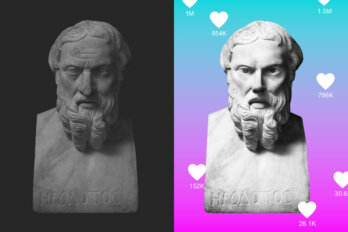I’ve never felt that the gaming world was for me—particularly since the Gamergate movement took over social media in 2014. The seemingly never-ending onslaught of internet misogyny and sexism levelled at women in gaming, and especially women indie-game developers such as Zoë Quinn and Brianna Wu, made me all too aware that I didn’t belong. As a queer woman, it never felt safe.
So I was surprised when, last year, while nursing a hangover with my partner and my best friend, our conversation turned to gaming. Mostly, I told them, I imagined gaming culture as bros drinking Mountain Dew and logging hours into their massive multiplayer online role-playing games, like World of Warcraft, yelling hate speech through their headsets. I had no idea—as my friends would argue—that some online games were super gay or that members of the LGBTQ community were using them to explore their own sexuality, gender identities, and dating situations. I had no idea that gaming could be, well, fun—a tool for progress, even.
The term online game refers to any type of game that is played through the internet or over a computer network. Online games debuted in the early years of the internet. Islands of Kesmai, which was released in the mid-eighties, was one of the first commercial online role-playing games. Today, there are many popular online games and gaming communities, including, most notably, the personal-computer-based platform Steam (which had 67 million monthly players as of mid-2017, according to the most recent official numbers available) and Twitch, which allows people to watch or broadcast live streaming of gameplay (it has 2.2 million monthly broadcasters and 100 million-plus monthly visitors, including, at least occasionally, Drake). And while it’s true that the wider online gaming community has had its fair share of trash talk and misogyny—the aftermath of one Twitch user’s viral misogynistic rant in November 2017 had many streamers call for clearer rules on the platform—it has also created many thriving sub—communities.
For many LGBTQ gamers, dating sims, or relationship-simulation role-playing games, are particularly groundbreaking. With interactive text, colourful animations, and engaging storylines, the often progressive queer world of dating sims has largely been hidden deep inside the misogynistic trenches of the gaming industry. Increasingly, however, these more progressive communities are making a space for themselves in the gaming world. These games are part resource-management simulator, part conversational sim—and entirely designed to let a person flirt safely and respectfully with the simulated character of their choice. Depending on the storyline, characters can develop a romantic interaction and learn about everything from sexual desires and social cues to flirtation and romantic connection.
What’s key for LGBTQ people, and especially youth and young adult game players, is that, unlike in real life, in these queer dating sims there are no threats of physical violence, slurs, bullying, or harassment. The games can also help them to feel less alone, and that their desires and experiences are valid—something that makes these games unique in any world, real or simulated. In 2011, for instance, Egale Canada conducted a survey of more than 3,700 high school students in Canada that showed that 70 percent of participants heard the statement “that’s so gay” daily at school, while 48 percent had heard the terms “faggot,” “lezbo,” and “dyke” daily at school. But in the safe confines of dating sims, this type of bullying and rejection is largely unheard of. Players and developers have worked hard to cultivate the types of safe, welcoming spaces that all too infrequently exist in real life. I only wish they had existed when I was younger.
When I was a teenager in the mid-nineties, I wasn’t fully aware of my own sexuality and didn’t know how to explore it without feeling isolated or ashamed. I, too, sought out a digital safe space. Back then, I found it in chat services like Internet Relay Chat, an application that facilitated group communication in its various discussion forums. Those spaces saved me the awkwardness of real, in-person human interaction. Behind a screen, it was easier for me to talk about the different thoughts or feelings I was having and, more importantly, to embrace them in whatever shape or form they came in.
While the idea of the internet being an idyllic safe haven is, admittedly, not always accurate, the digital safe space fostered by and found in dating sims and their corresponding communities can be vital for queer folks. Today, not only can these digital safe spaces act as a sanctuary, like they did two decades ago for me, but they can allow us to connect with our own sexualities and identities and to learn about ourselves. Within the careful boundaries of a simulated storyline, game players can be taught about things like consent and clear communication. Depending on the story pathway one chooses, players can be open about their affections and inner desires with one or more simulated characters, without the fear of retaliation. Dating sims provides a space to explore who we are, which is something we might not have in our own offline communities, depending on geographical location and a whole host of other factors.
Growing up in small-town Ontario, Megan Patterson often felt out of place. She was surrounded by conservative ideals in and out of her household—her father once told her that she wasn’t allowed to be gay. To Megan, finding a queer community not only seemed daunting but nearly impossible. She felt isolated—she knew she wasn’t 100 percent straight and, in her own words, felt unable to examine those feelings more deeply. And so Patterson started to privately role-play the male characters in the farming game Harvest Moon. Looking back, she says she wanted to both feel powerful and to experience male privilege adding, “It also felt like a safe way to explore feelings I didn’t really understand.” At first, she was scared of how it made her feel—liberated—but, at the same time, she felt empowered. “I wasn’t able to explore these feeling in real life,” she says. “And it was a way for me to fully express and explore my sexuality. For a long time, I felt more comfortable exploring my sexuality this way.”
Adrienne Shaw is a professor at the Temple University’s Department of Media Studies and Production and a member of the Lew Klein College of Media and Communication’s graduate faculty. Shaw oversees the LGBTQ Game Archive, which documents the history of lesbian, gay, bisexual, transgender, and queer content in games. She points out in her research that, even before dedicated spaces for LGBTQ dating existed in gaming, many people created them within existing formats and communities—take, for example, Second Life, an online, virtual world, which launched in 2003. When people grew bored with the intended parameters of the game, they created sex spaces and sex businesses that interested them. “It’s really important,” she says, “to be able to explore your sexual interests away from people in a way that lets you ask, ‘Am I interested in this?’ while not hurting anyone in the process”—including yourself.
Today, some games are explicitly designed to help LGBTQ youth navigate challenging situations that may potentially happen in real life. Southern Ontario–based developer’s Bloom Digital Media, for example, created the dating sim LongStory to help players explore the multi-faceted world of LGBTQ dating, including the good and bad. Bloom Digital Media founder Miriam Verburg originally developed the game as a response to the deaths of Amanda Todd and Rehtaeh Parsons, who were both cyberbullied. Through LongStory, players can pick storylines that work through the challenges of mental health, consent, bullying, and sexuality. The game, in turn, helps them to navigate these potentially challenging situations in their own digital safe space.
Not all LGBTQ-friendly sims have such heavy issues at their core. Hatoful Boyfriend, my first dating sim, is about a human hunter-gatherer who goes to a high school for birds. At the core of the game, you, the player, are trying to romance and date pigeons. Yes, pigeons. The game was originally released in Japan in 2011 and came to North America in 2015, where it gained popularity in the LGBTQ community (and elsewhere) for being a quirky, warm-hearted, and unpretentious role-playing game. While not specifically packaged as a game for queer players, Hatoful Boyfriend drew many in the LGBTQ community for its ability to explore unusual relationship dynamics regardless of gender, orientation—or species.
Like me, Torontonian Kaitlin Tremblay also discovered dating sims via Hatoful Boyfriend. She started playing the game in 2015 and found it to be “funny, odd, and eccentric” and a nice change from the other storytelling games she played. But, eventually, she wanted a game that delved deeper into a queer narrative arc, and she began to seek out other games that would let her delve into her own queerness, the awkwardness of flirting, and the thrill of sexual tension. Friends told her about Ladykiller in a Bind, a dating sim that explores kink and queerness—an entirely different world from parody dating sims like Hatoful Boyfriend. She says that it’s important for queer folks to create spaces where the full spectrum of their desires are seen as valid, real, and worthy of being talked about. Ladykiller in a Bind follows the arc of a submissive queer girl. For Tremblay, the game provides full agency to explore what can come from a kink relationships. “It lets queer relationships be fully three-dimensional,” she says, “including both the good and the bad of it.”
At their best, both dating sims and game relationships allow players to explore their own humanity in ways they don’t otherwise get a chance to, adds Shaw. By playing the game, users can explore the types of relationships they can have with others, as well as the types of genders and personalities they are attracted to—and even what forms of love they might want. But while Shaw’s research shows there has been an increase in dating sims, she admits that there is still a lot of work to do.
In other words, yes, we should celebrate the upswing of gay and lesbian relationships representation in games, as well as the very slight increase—from nothing to something—in trans, non-binary, and bisexual relationships. We should also cheer the fact that some games, like Hustle Cat and LongStory, give players the ability to choose pronouns, appearance, and, in the case of Hustle Cat, even make an entire non-binary-friendly character. But there is still a long way to go, particularly when it comes to representing the complexity of LGBTQ communities and relationships.
Everyone has a potential role to play as the gaming world expands. Steve Gaynor is a thirty-five-year-old straight, white man and also the cofounder of Fullbright, based out of Portland, Oregon, which developed the queer-friendly games Gone Home and Tacoma. Gone Home, released in 2013, includes the story of a teenage girl in the nineties learning about her own sexuality and coming out to parents, who don’t accept her. Gone Home won multiple awards, including game of the year from Polygon, an American video-game website run by Vox Media.
Fullbright’s game, Tacoma, released in 2017, is a narrative story game about chasing holographic ghosts, with multiple LGBTQ character arcs. While developing their two games, Gaynor and the other Fullbright cofounder, Karla Zimonja, reached out to people in the game industry and beyond who identify as LGBTQ to help develop characters, to share personal experiences, and also provide input on whether the characters and their storylines felt authentic. “Having those perspectives and not relying on our own naive assumptions about this stuff is really important,” says Gaynor. “We try to do our best with involving more people in the process.”
For many transgender people, finding a game or character to identify with can be difficult. Enter Dream Daddy: A Dad Dating Simulator, released in July 2017. Players in this dating game create a dad character that meets and romances other dads in social situations. It was unapologetic in its transgender options, a move creators made on purpose and for good reason. Dream Daddy has a transgender character named Damien, as well as varying character creation options, including choices of different dad bods, races, and even a binder option (a binder helps trans and non-binary folks flatten breast tissue to create a male-appearing chest). “We wanted everyone to be able to see themselves in this game,” says Leighton Gray, co-creator of Dream Daddy, “and for young and old queer folks alike to feel included in these loving narratives when they’re so often excluded or erased.”
The game became a bestseller on Steam and, perhaps predictably, it also faced some backlash. Anybody who chooses to pursue Damien’s character will likely notice that it’s never explicitly mentioned that Damien is transgender within the game—a detail that only showcases the sheer difficulty game designers face when trying to present and offer a truly nuanced trans character. Gray, who is queer herself, explains that the goal of Dream Daddy was to have a game that showcases healthy, supportive queer relationships. “I’ve had to navigate the scary, uncomfortable, and isolating waters that come with just existing as a queer person for most of my life,” she says. “Dating sims are really useful for young queer or questioning folks to explore their sexuality, gender, preferences, and relationships when they might not be able to in real life.”
I wish things could have been different when I was growing up. In the world, there aren’t many places where we’re encouraged to reflect inward and learn about ourselves. “Having a digital space to explore this desire, in a truthful way,” says Tremblay, “would have saved me years of hurt and pain at rejecting parts of myself because so many people and so much media told me I didn’t exist.” I know what she means. For years, as I clumsily fumbled around trying to find my sexual identity, I frequented gay bars and was told by the women I was trying to flirt with that I presented “too hetero” for them.
The older I got, I was told, online and off, that my multiple heterosexual relationships somehow invalidated my feelings and affections toward women—that perhaps I was confused or my sexuality was faked. After so many of these encounters, I was often left questioning if I really was who I thought I was. Nobody should have to think or feel that way, and I’m thankful that, as an adult, dating sims provided me the space and outlet to explore my identity in ways I never thought possible. Using levity and wit, it’s become an educational tool for me—and, apparently, for so many others too.






